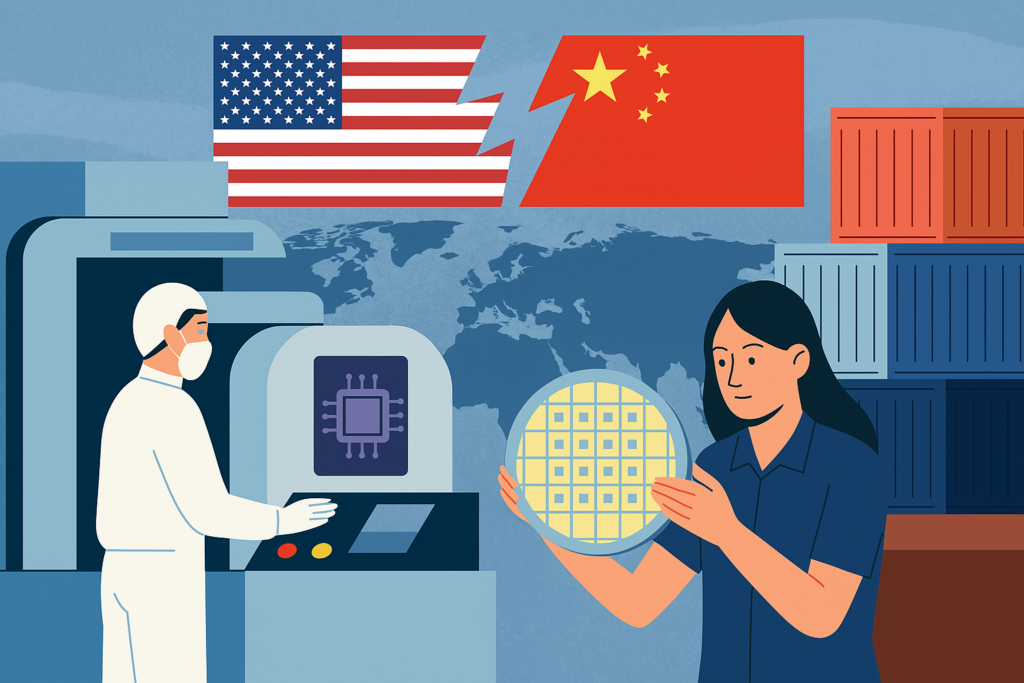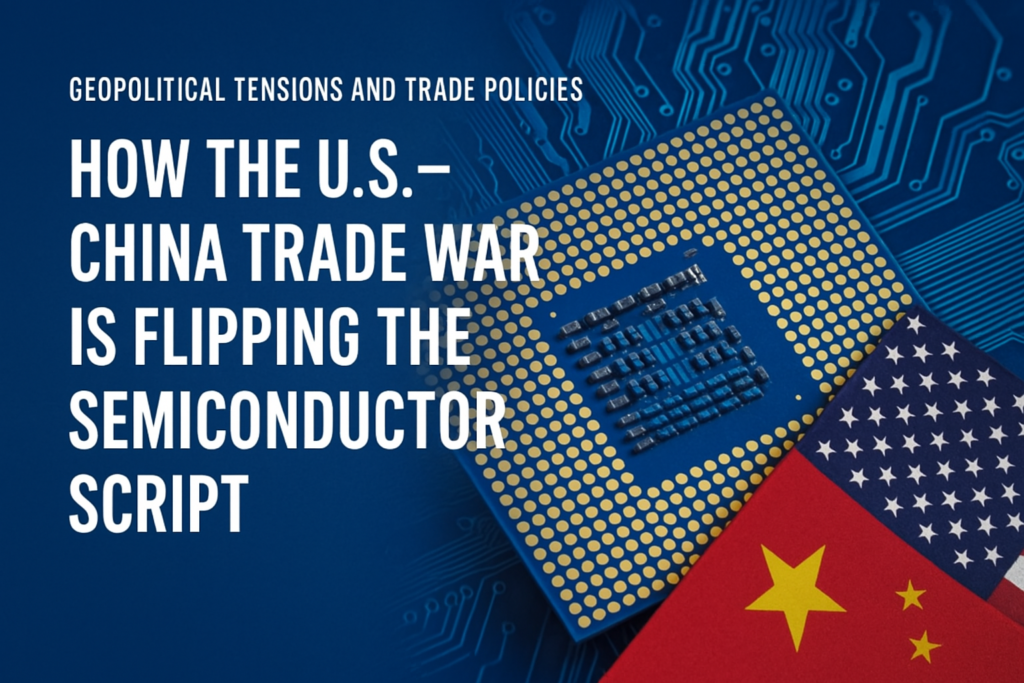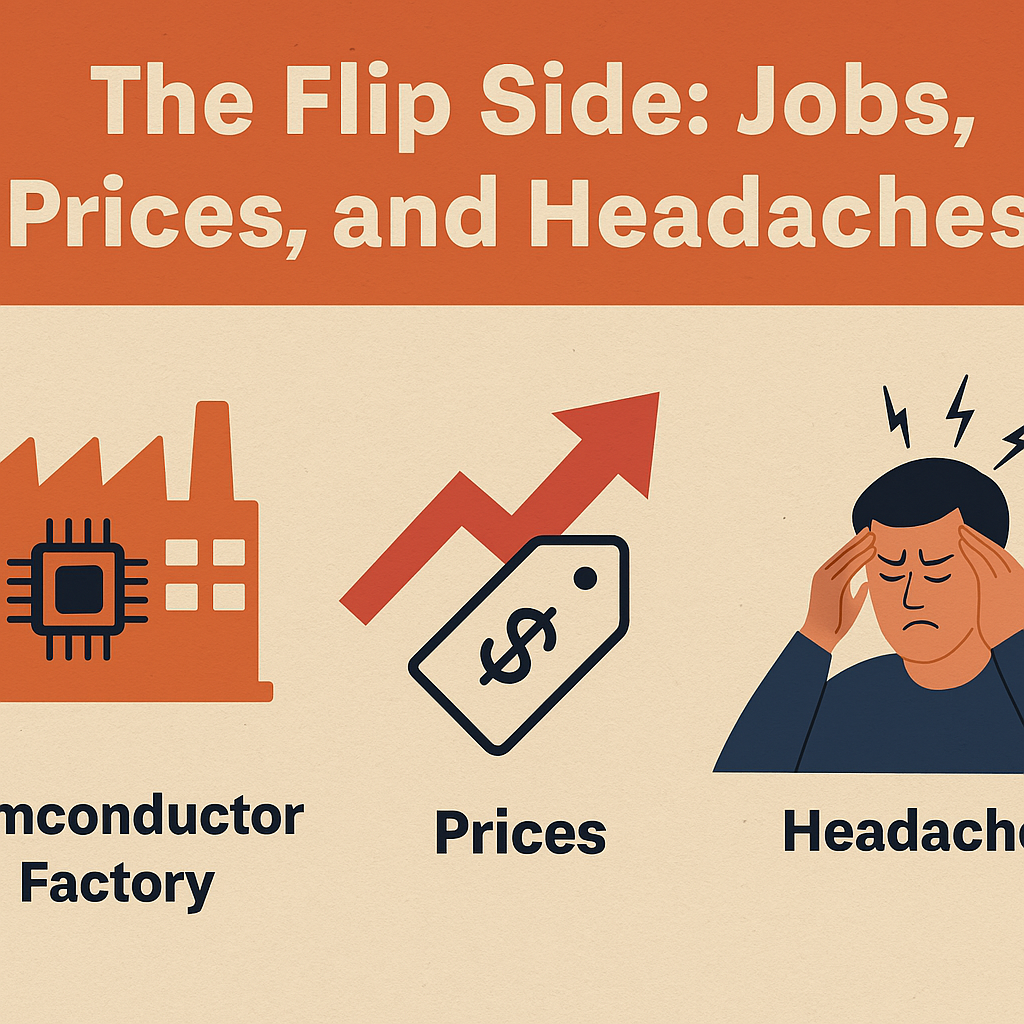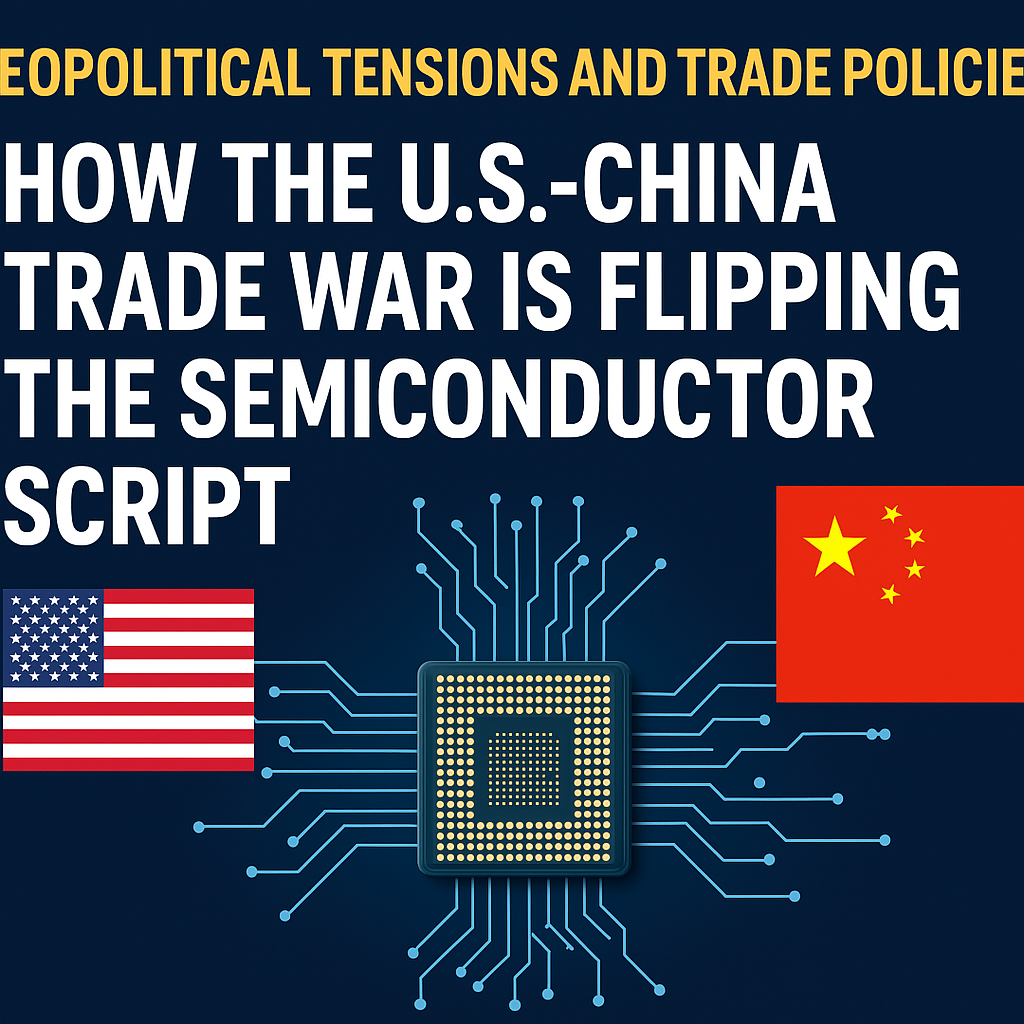How the U.S.-China Trade War Is Flipping the Semiconductor Script
Geopolitical Tensions and Trade Policies
Hey, you! Yeah, you—the one wondering why your shiny new gadget costs more than your rent these days. Ever thought about how a beef between two big-shot countries could mess with something as small as a microchip? Well, grab a coffee, because we’re about to unpack how the U.S.-China trade war, export controls, and tariffs are shaking up the global semiconductor supply chain and pushing nations to scramble for tech self-sufficiency. It’s a wild ride, and trust me, it’s not just nerd stuff—it’s about who’s got the power in this tech-driven world.
Detailed Trends Table
Below is a table summarizing key trends for 2025, extracted from various sources:
| Trend Name | Description | Examples/Applications | Relevant Numbers/URLs |
|---|---|---|---|
| U.S.–China Trade War Impact | Tariffs and export controls disrupting semiconductor supply, pushing for self-sufficiency. | Huawei’s pivot to domestic chips, TSMC’s U.S. investment. | Marketplace |
| CHIPS Act Investments | $52 billion for U.S. manufacturing, creating jobs and new fabs. | TSMC Arizona, Intel Ohio, over 115,000 jobs expected. | Commerce Department |
| China’s Semiconductor Push | Investments in domestic production, aiming for 20% self-sufficiency by 2025. | SMIC’s 5nm chips, Huawei’s leadership. | S&P Global |
| EU and Japan’s Response | EU Chips Act for 20% market share, Japan’s partnerships for next-gen chips. | TSMC Dresden, Kioxia–Sony collaboration. | Z2Data |
| Talent and Supply Chain Challenges | Shortages delaying projects, higher costs due to fragmented supply chains. | TSMC Arizona delays, higher chip prices. | CIO |
The Chip Chaos Kicks Off: A Global Wake-Up Call
it’s 2020, the world’s a mess with a pandemic, and suddenly car companies can’t build trucks because they’re missing tiny chips. Fast forward to April 2025, and we’re still feeling it. Why? For example, the U.S.-China trade war threw a massive wrench into the semiconductor supply chain. These little silicon wonders—running everything from your phone to your smart toaster—are mostly made in places like Taiwan and South Korea. But when the U.S. and China started slugging it out with tariffs and bans, the whole system went haywire.
As a result, nations started asking some big questions: What if we can’t get chips when we need ‘em? Consequently, everyone’s racing toward self-sufficiency in semiconductors amid trade wars. It’s like the world woke up one day and realized it’d been too cozy relying on a handful of countries for tech’s lifeblood.
How It All Began: Superpowers Throwing Punches
Let’s rewind a bit. This U.S.-China tech rivalry chips saga didn’t just pop up outta nowhere. For instance, back in 2018, the U.S. hit China with tariffs—25% on billions of dollars’ worth of goods—claiming they were stealing tech secrets. China wasn’t having it and slapped tariffs right back. What’s more, the U.S. rolled out export controls, targeting companies like Huawei and cutting them off from American chips and software. It was like locking the candy store and keeping the key.
China’s response? “Fine, we’ll make our own candy!” However, building cutting-edge chips isn’t like baking cookies—it takes billions, fancy tools, and years of know-how. The U.S. still holds big cards here, with companies like Intel and tech from firms like ASML. So, how’s this U.S.-China semiconductor trade war reshaping the game? Let’s dig in.
Tariffs Hit Hard: Costs Climb, Plans Shift
You might be thinking, Tariffs are just taxes, right? Sure, but when you tack tariffs onto tech parts, it’s a whole different beast. For example, costs spiked, and companies had to rethink everything. Taiwan’s TSMC, the chip-making champ, got stuck in the middle—supplying U.S. giants like Apple while dodging global chip supply chain tensions with China.
To illustrate, my pal Sarah runs a small electronics startup in Oregon. Last year, she told me they had to delay a new gadget launch because tariffs reshaping the semiconductor industry in 2025 jacked up their chip prices. “We were calling suppliers nonstop,” she said, “from Japan to Germany, just trying to keep it together.” This led to late nights and a lot of coffee—and it’s a perfect snapshot of how tariffs and chip supply chain issues hit real people, not just headlines.

China’s Strategy: Made in China 2025 and Beyond
China’s response, via Made in China 2025, aims for semiconductor self-sufficiency, with investments exceeding $100 billion, including the Big Fund (CSIS). By 2025, estimates suggest China could meet 20% of its demand, with advancements in 5nm chips for smartphones and automotive tech (S&P Global). Yet, it faces hurdles, with U.S. controls limiting access to advanced tools, potentially slowing progress.
U.S. Countermeasures: The CHIPS Act and Domestic Investment
The U.S. countered with the CHIPS and Science Act, signed in 2022, allocating $52 billion for manufacturing and R&D. By April 2025, over $30 billion in investments have been announced, with 23 projects in 15 states, creating over 115,000 jobs (Commerce Department). Key projects include TSMC’s Arizona fab, starting 4nm production in early 2025, and Intel’s delayed Ohio fabs, now slated for 2030 (Tom’s Hardware). These efforts aim to boost supply chain resilience, reducing reliance on Asia.
Global Trends: EU, Japan, and Beyond
The push isn’t limited to the U.S. and China. The EU’s Chips Act, launched in 2023, targets a 20% global market share by 2030, with investments in fabs like TSMC’s Dresden plant (Z2Data). Japan’s investing in partnerships, like Kioxia and Sony, to develop next-gen chips, driven by geopolitical tensions and supply chain risks (McKinsey).
Export Controls: The Tech Wall Goes Up
Now, let’s talk export controls. In 2022, the U.S. dropped a bombshell: strict rules banning advanced chip-making tech—like those crazy-precise lithography machines—from heading to China. For instance, this hit companies making chips for AI and 5G square in the gut. The idea? Keep China from catching up in the U.S.-China tech rivalry chips race.
However, China didn’t just sit there sulking. Instead, they’ve poured cash into their own chip game, aiming for tech self-sufficiency trade policies. Take SMIC, China’s big chip maker—they’re churning out 7nm chips now, not quite TSMC’s 3nm level, but impressive given the impact of export controls on global chip manufacturing. Thus, it’s a tug-of-war: the U.S. slows China down, but it’s lighting a fire under their innovation.
Self-Sufficiency Fever: Everyone’s In On It
In addition, this isn’t just a U.S.-China thing—everyone’s jumping in. For example, the U.S. passed the CHIPS Act in 2022, tossing $52 billion at domestic chip production. Intel’s building huge plants in Ohio, and TSMC’s got a shiny new fab in Arizona kicking off this year. Similarly, Europe’s got its own EU Chips Act, aiming to double its chip market share by 2030. Even India’s in the mix, luring manufacturers with sweet deals.
On the other hand, China’s Made in China 2025 plan is in overdrive. Despite that, they’re still playing catch-up—export controls mean they can’t get the best tools, so they’re improvising. Nevertheless, they’re training engineers and stacking cash, betting big on self-sufficiency in semiconductors amid trade wars. Can they pull it off? Time’s gonna tell.
A Real-Life Tale: Mike’s Truck Trouble
To illustrate how this hits home, let me tell ya about my neighbor Mike. Back in 2021, he ordered a new pickup—nothing fancy, just a work truck. Months passed, no truck. Why? Because of this, the global semiconductor supply chain changes due to tariffs left carmakers scrambling for chips. Factories shut down, prices jumped, and Mike ended up paying $4,000 extra for a used rig instead. “I just wanted to haul lumber, not fund a trade war,” he griped, shaking his head. For example, that’s how U.S.-China tensions on chip supply chains trickle down to regular folks like Mike.
Innovation Sparks Fly: Pressure Makes Diamonds
What’s more, there’s a silver lining here. For instance, when you choke off supply, people get clever. In the U.S., startups are messing with open-source designs like RISC-V—kinda like the DIY version of chips. Likewise, China’s tinkering with stuff like graphene to dodge silicon limits. As a result, the trade war’s role in advancing semiconductor technology is kicking things into high gear.
To illustrate, TSMC’s $12 billion Arizona plant—set to pump out chips this year—is a direct response to global chip supply chain tensions. Samsung’s doubling down in Texas too. It’s like a tech gold rush, with everyone staking claims. Thus, the semiconductor innovation trade war isn’t just survival—it’s a creative explosion.
The Flip Side: Jobs, Prices, and Headaches
However, let’s not sugarcoat it—this ain’t all fun and games. For example, jobs are shifting as new factories pop up, but they’re disappearing elsewhere. In addition, tariffs and trade war semiconductor shortages mean your next phone might cost more. On the other hand, the uncertainty’s brutal—businesses can’t plan when rules change faster than a TikTok trend.
I ran into my old coworker, Dave, a logistics guy, at the store last week. “Clients are losing it,” he said, tossing chips into his cart. “One minute it’s tariffs, the next it’s a ban. We’re guessing half the time.” That’s the real human cost of effects of U.S.-China tensions on chip supply chains—stress, guesswork, and a lotta grumbling.
What the Experts Say: Straight Talk
So, what do the pros think? Gartner’s analysts say geopolitical impact on semiconductors will keep driving innovation, but don’t expect stability ‘til 2027-ish. Similarly, McKinsey warns that chasing tech self-sufficiency could split the market, hiking prices long-term. For instance, TSMC’s boss, C.C. Wei, put it blunt in a 2024 call: “Geopolitics is a wild card. We’re tougher for it, but it’s a rollercoaster.” Thus, the big shots see both promise and pain ahead.

Dig Deeper: Links for the Curious
Wanna nerd out more? Grab Chip War by Chris Miller on Amazon—it’s a wild ride through this saga. Alternatively, peek at Reuters for the latest on U.S.-China trade policies and semiconductor innovation. It’s all there, no fluff.
The Big Picture: Where’s This Heading?
In short, the U.S.-China semiconductor trade war is a power play with chips as the prize. For example, export controls semiconductor industry moves keep China hustling, while the U.S. bets big on home turf. In addition, tariffs and chip supply chain chaos are forcing everyone to adapt, and geopolitical tensions driving tech self-sufficiency are rewriting the rules.
So, will this make tech better or just pricier? Perhaps both. Nations are sprinting toward tech self-sufficiency trade policies, but the global semiconductor supply chain might stay choppy. Ultimately, it’s a high-stakes showdown, and we’re all watching—or paying for it at the checkout.
In Conclusion: Your Turn, Reader
All things considered, we’ve covered a lot—tariffs, bans, new factories, and Mike’s truck woes. The U.S.-China trade war isn’t some distant tech tale; it’s hitting our wallets and our future. As a final point, next time you’re mad about a delayed gadget, you’ll know the backstory.
What’s your take? Will this reshaping semiconductor supply chains save the day or just make life harder? Hit me with your thoughts below—I’m dying to hear ‘em. Plus, if you’ve got a buddy still salty about chip prices, share this with ‘em. Let’s keep the chat rolling!

Key Citations

